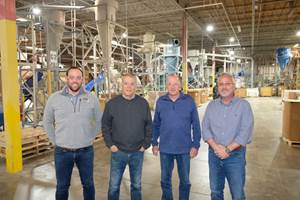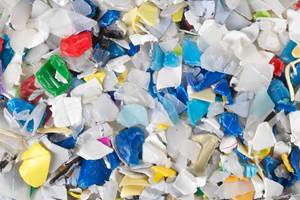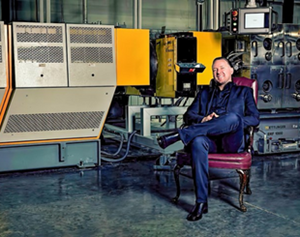NPE 2006 News Wrap-Up: Recycling and Scrap Reclaim
NPE was full of new equipment and systems for recapturing valuable in-plant scrap and post-consumer/post-industrial plastic waste. Recovery of PET packaging and film or fiber waste were particular areas of emphasis, as were lots of new granulators, from the world’s biggest to micro-size and even ‘clean-room’ models.
With resin prices so high, the NPE show in Chicago last month was an opportune time for processors to hear about more efficient, durable, and cost-effective equipment for putting scrap and recycle back into the production stream. Recycled PET (RPET) is already in high demand, but a ferment of new technological development has been spurred by a program of “challenge grants” started in 2003 by the California Dept. of Conservation, which is handing out $10 million a year to increase bottle recycling in that state. NPE previewed new hardware modules designed to improve recycling efficiency and flake and pellet quality. Several other product introductions tackled the tough job of recycling film and fiber.
For in-plant reclaim, NPE exhibitors previewed huge new granulators and extra-tall hoppers for increasing throughput, as well as faster ways to replace knife blades. Meanwhile, slow and steady is the approach of new screenless press-side granulators with rotor speeds as low as 22.5 rpm to reduce noise and dust. A variety of models sported new horizontal feeding mechanisms for higher throughput, and several firms exhibited lower-priced Chinese-built machines.
New RPET technologies
While several large PET recyclers developed their own “dry” cleaning systems for PET flake, there is now one available commercially here from B+B Anlagenbau GmbH of Germany. Its new TR unit uses mechanical friction to remove 80% to 90% of paper labels, adhesive, sand, glass, and other contaminants. It makes subsequent wet washing of PET flake more efficient by reducing water consumption and water clean-up.
The TR unit has a screen cage with a rotor and paddles. In the cage, flakes collide with each other, freeing contaminants, which are flung out by centrifugal force through perforations in the screen and removed by a screw under the cage.
The body of the machine is identical to the dry cleaning unit developed by Pla.to GmbH (formerly Systec) in Germany to clean film and mixed flake. B+B builds Pla.to’s machine and licenses its technology for the TR unit. Japanese shredder maker Kurimoto Ltd. also licenses Pla.to’s technology.
B+B’s TR units come in four sizes up to 6600 lb/hr. After dry cleaning, B+B’s PET recycling line puts the flake through air classification and into the firm’s new HWK continuous hot washer. The latter resembles a carousel with wedge-shaped chambers, each stirred by a propeller. Propeller and carousel speed can be varied to change agitation and retention time according to the flake contamination level. Ground PET flake is screw-fed into the chambers, and the ratio of solids to washing liquid in the chambers can also be varied.
The show highlight for Amut of Italy was the first North American installation of its friction washing plant for PET at Global PET Inc. in Perris, Calif., recipient of one of California’s new challenge grants. The system uses about a pint of water per pound of clean flake, considerably less than competing processes, says Amut. The 30-million-lb/yr plant has Amut’s latest development—closed-loop filtration of the hot caustic cleaning solution.
Sorema Div. of Previero Srl in Italy (U.S. rep is Common Sense Solutions) launched a three-screen, continuous-belt screen changer for recycling. It uses an inexpensive belt instead of more costly welded screen packs. To eliminate wear, the seals hydraulically retract and extend around the three melt-flow openings. Because it doesn’t backflush, less polymer is lost.
Sorema also presented a new two-stage device for size reduction and classification. It is a new module to remove a barrier layer from PET bottle flake after washing and drying. A special blade creates friction that removes the barrier layer as powder. Flake is then elutriated and screened. More uniform flake size with the new module makes solid-stating (to restore I.V.) more efficient, Sorema says.
Starlinger & Co. of Austria (U.S. office is American Starlinger-Sahm) discussed its new ViscoStar semi-continuous SSP reactor for solid-stating recycled PET. Larger than previous units, ViscoStar handles flake as well as pellets. It will be shown for the first time at a company open house in September.
BKG Bruckmann & Kreyenborg Granuliertechnik, part of the Kreyenborg group, showed a new pelletizer that crystallizes PET with no external heat source, using only the retained heat from pelletizing. Typically crystallizing takes place in a separate unit.
BKG’s device gives pellets a very short time under water before centrifugal drying. The orifice of the dryer leads to a crystallizing conveyor, 2 to 3 meters long. Crystallizing takes 5 to 12 min. Originally built for large resin producers, the system is now available for any size BKG underwater pelletizer.
Also new from Kreyenborg is the Impact Backflush screen changer with four melt channels. A vertical valve creates pressure, then releases it suddenly, popping debris off screens with suction. This reportedly cleans screens more completely than flow reversal alone.
Hamos GmbH of Germany (affiliated with Bunting Magnetics) promoted its method of cleaning PVC window-profile regrind by electrostatically separating rigid PVC from rubber or plasticized PVC. The same electrostatic machine can also separate PVC from PET bottle flake or make other dual-material separations.
Meanwhile, Granutech-Saturn Systems reported that it is developing its first quad-shaft shredder, which will shred whole bales of PET bottles.
Reclaiming film & fiber
Hosokowa Polymer Systems displayed a photo of what’s said to be the world’s biggest granulator—a 600-hp unit with a 10-ft-long cutting chamber for biaxially oriented film. When biax film goes out of spec, it piles up at 2000 ft/min, a rate that would quickly overwhelm a plant. So these granulators are buried in the floor to grind film as it’s produced until the process is under control again. Four of these behemoths have been installed.
Cumberland Engineering’s large 3284 unit, also for biax film shredding, has new replaceable knife seats that make knife repair less expensive. Adjustable rotor knives also maintain a constant cutting circle as knives wear.
A new horizontal feeding mechanism raises output for low-bulk-density reclaim. NGR-Next Generation Recycling maschinen from Austria launched X:Gran 165, said to be the world’s largest one-step recycling line. It starts with a 6 x 6 x 7 ft hopper sized for whole bales of fiber, raffia, nonwovens, carpet or rigid scrap. It feeds a bale into a single-shaft shredder, from which shredded material falls into a vertical auger feeding a single-screw reclaim extruder and pelletizer.
Starlinger recently installed a new recycling system for PET nonwovens, consisting of a single-shaft shredder, RecoStar Basic single-screw extruder with two vacuum vents, a double-piston continuous backflush screenchanger, underwater pelletizer, crystallizing dryer, and solid-stating unit.
For high throughput of film and fiber, Vecoplan LLC introduced the RG52 FF HT single-shaft shredder. It combines the recently developed SureCut rotor, which eliminates wrapping of film and fiber, with the HiTorc gearless, permanent magnet motor to maintain constant torque at all motor speeds and reduce noise, wear, and energy consumption. It can also reverse rotor direction in 2 sec to clear jams.
Meanwhile, Macchi North America showed its RecoTrim edge-trim repelletizer with a novel corotating twin-screw extruder consisting of one long and one short screw. The twin-screw segment is only a feed zone of 3 to 4 L/D, which pulls in the edge trim before making the transition to a 10:1 L/D single-screw section. The previous RecoTrim unit had only a single-screw extruder. Macchi builds the twin/single-screw extruder in one size (90 lb/hr) and has delivered 250 worldwide in the past two and a half years.
Hamilton Avtec showed a new AR200 with a special rotor design for medium-speed (190-rpm) film cutting.
Precision AirConvey is the new North American representative for film-scrap repelletizers from Plasmac Ltd. in the U.K. Plasmac builds three lines of repelletizers for edge trim, roll scrap, and other film waste.
Republic Machine Inc. launched the innovative Split-A-Part EZ Service Universal single-shaft shredder. It’s a low-speed, ram-fed shredder for film and carpet waste in three sizes with 42- to 62-in. rotors and a trapezoidal cutter. The unit’s Zoidal Cutter prevents wrapping and heat buildup.
Munchy introduced a complete redesign of its dual-diameter recycling extruders. Standard features now include touchscreen controls, AC vector motor, and direct drives instead of belts and pulleys for lower maintenance. The infeed rollers are also direct-driven, replacing chain drives and allowing reverse feed to clear jams.
Munchy’s dual-diameter screw design has a new incisor tooth to help break up roll-fed film and prevent wrapping. The tooth also increases output because feeding is more even. New auto pellet-length control compensates for changes in infeed rate by adjusting die-face cutter speed. Air cooling of pellets is available for higher output–up to 330 lb/hr vs. 220 lb/hr before.
Press-side granulators
The smallest granulator at the show was a 0.75-hp micro model from Getecha designed for sprues and runners from micromolding—probably the first of its kind. The tiny unit has a 3 x 5 in. cutting chamber and rotor with four fixed knives. Knife clearance is only 0.004 to 0.005 in.
Cumberland now uses outboard bearings for tight knife tolerances on all its press-side products, achieving 0.003- to 0.004-in. knife gaps.
Size Reduction Specialists introduced a clean-room version of its low-speed Bi-Cutter, which has two rotors, one over the other. Slow grinding makes less dust in the first place; and the hopper and magnetically sealed cutting chamber are designed to keep dust in.
Cumberland brought out its first clean-room granulator. It has a 6.5 x 12 in. cutting chamber and uses a new system of sequencing trap doors and negative air pressure to keep dust from escaping. The unit is also sound-proofed with a foam-lined steel enclosure, emitting only 40-50 dBA.
Other OEMs like Getecha and Gloucester-CMG also showed improved soundproofing for granulators.
Meanwhile, SRS also introduced a Tri-Cutter granulator with three separate rotors in a vertical stack, progressively reducing particle size. This creates very small granulate for reuse in small injection machines.
Rapid Granulator’s new 150 Series granulators feature a cutting chamber with a redesigned rear wall, tangential feed, and compact controls that make it 15% smaller than comparable press-side units (23.5 in. deep x 16 to 26 in. wide for 40 to 145 lb/hr). They have a 3 or 5 hp motor and robotic feeding. Otherwise it has the traditional Rapid rotor design with medium speed (190 to 225 rpm) and two bed knives. It corresponds to Conair’s new NCR series, built by Rapid for Conair (we reported on these in May).
Cumberland is expanding its low-speed granulator line with the S-Series, available in three sizes, which turn at possibly the lowest speed in the industry—22.5 rpm, yielding very little dust for medical and electronic molding.
Moditec from France (U.S. distributor is Plastec) presented its new Goliath Plus and Titan Plus ultra-low-speed granulators. They run as slow as 25 rpm for very low dust and little resin degradation. Moditec also introduced its Integrated Metal Detector.
Hamilton Avtec now offers acrylic hoppers for its SG24 and A8 series, which run as slow as 32 rpm. Acrylic hoppers are quieter and let an operator see what’s going on from any angle without compromising safety.
Granutech-Saturn Systems showed new cutter-blade holders designed to make blade changing faster.
Republic’s single-shaft shredder mounts bed knives on a moveable anvil, which allows faster (1-hr) knife changes.
More granulator news
Other big granulators at the show included Rotogran International’s 200-hp model WO3052, which has a new “tall boy” hopper.
Herbold Meckesheim GmbH in Germany (U.S. office is Resource Recycling Systems) showed an SML 60/100 S7-2 SB2 granulator for the first time with a patent-pending horizontal feed auger. Horizontal feeding produces 30% to 50% higher throughput than traditional gravity feed, Herbold says.
Vecoplan recently introduced XL Industrial shredders in four models to grind large, bulky items. The XL package is available on Vecoplan’s RGU models. Vecoplan also launched the VH horizontal series in 14 models with conveyor feeding of long scrap such as profiles, siding, and small pipe.
A lot of new equipment at NPE was the result of cooperation between U.S. and Chinese or Taiwanese firms to reduce machine-building cost. Avian USA brought five models of “German-style” rotary grinders built in China.
Norwell Plastics represents granulators from Kingswell Plastics Machinery in China. A dozen models offer throughputs of 220 to 3740 lb/hr.
Mould-Tek Industries highlighted new grinders and shredders imported from Taiwan with up to 200 hp.
Major-Max Management Corp., near Chicago makes granulators from 25 to 130 hp in China.
Related Content
Evolving Opportunities for Ambitious Plastics Recycler
St. Joseph Plastics grew from a simple grinding operation and now pursues growing markets in recycled PP, food-grade recycled materials, and customized post-industrial and post-consumer compounds.
Read MoreLooking to Run PCR on a Single Screw? Here’s What to Keep in Mind
Just drop it in and mix it up? Sorry, there’s a lot more to it than that. Here is some of what you need to consider.
Read MoreA Recycling Plant, Renewed
Reinvention is essential at Capital Polymers, a toll recycler that has completely transformed its operation in a short period of time.
Read MoreCompatibilizers Aid Recycling & Upcycling of Mixed Resins
Compatibilizers are proving their worth in boosting critical properties such as impact/stiffness balance of PCR and PIR blends of polyolefins and other plastics.
Read MoreRead Next
Advanced Recycling: Beyond Pyrolysis
Consumer-product brand owners increasingly see advanced chemical recycling as a necessary complement to mechanical recycling if they are to meet ambitious goals for a circular economy in the next decade. Dozens of technology providers are developing new technologies to overcome the limitations of existing pyrolysis methods and to commercialize various alternative approaches to chemical recycling of plastics.
Read MoreProcessor Turns to AI to Help Keep Machines Humming
At captive processor McConkey, a new generation of artificial intelligence models, highlighted by ChatGPT, is helping it wade through the shortage of skilled labor and keep its production lines churning out good parts.
Read MoreTroubleshooting Screw and Barrel Wear in Extrusion
Extruder screws and barrels will wear over time. If you are seeing a reduction in specific rate and higher discharge temperatures, wear is the likely culprit.
Read More



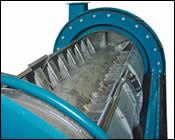

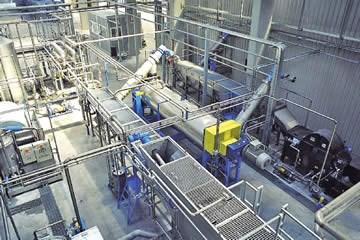
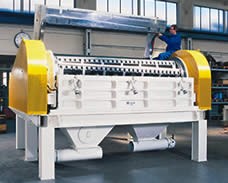
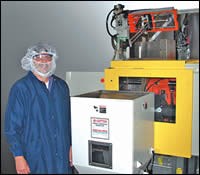











.png;maxWidth=300;quality=90)







